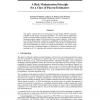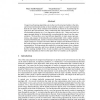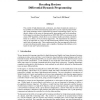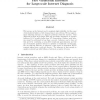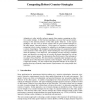NIPS
2007
14 years 1 months ago
2007
This paper1 explores the use of a Maximal Average Margin (MAM) optimality principle for the design of learning algorithms. It is shown that the application of this risk minimizati...
NIPS
2007
14 years 1 months ago
2007
NIPS
2007
14 years 1 months ago
2007
Unsupervised learning algorithms aim to discover the structure hidden in the data, and to learn representations that are more suitable as input to a supervised machine than the ra...
NIPS
2007
14 years 1 months ago
2007
The control of high-dimensional, continuous, non-linear dynamical systems is a key problem in reinforcement learning and control. Local, trajectory-based methods, using techniques...
NIPS
2007
14 years 1 months ago
2007
We present a new and efficient semi-supervised training method for parameter estimation and feature selection in conditional random fields (CRFs). In real-world applications suc...
NIPS
2007
14 years 1 months ago
2007
This paper proposes constraint propagation relaxation (CPR), a probabilistic approach to classical constraint propagation that provides another view on the whole parametric family...
NIPS
2007
14 years 1 months ago
2007
Web servers on the Internet need to maintain high reliability, but the cause of intermittent failures of web transactions is non-obvious. We use approximate Bayesian inference to ...
NIPS
2007
14 years 1 months ago
2007
It has been shown that adapting a dictionary of basis functions to the statistics of natural images so as to maximize sparsity in the coefficients results in a set of dictionary ...
NIPS
2007
14 years 1 months ago
2007
In transfer learning we aim to solve new problems using fewer examples using information gained from solving related problems. Transfer learning has been successful in practice, a...
NIPS
2007
14 years 1 months ago
2007
Adaptation to other initially unknown agents often requires computing an effective counter-strategy. In the Bayesian paradigm, one must find a good counterstrategy to the inferre...
